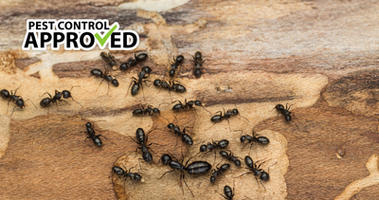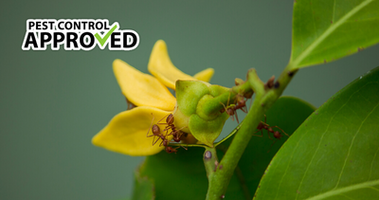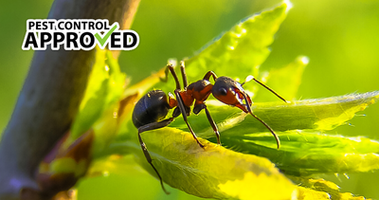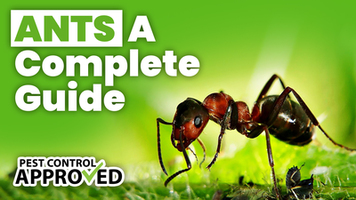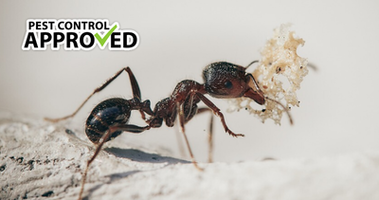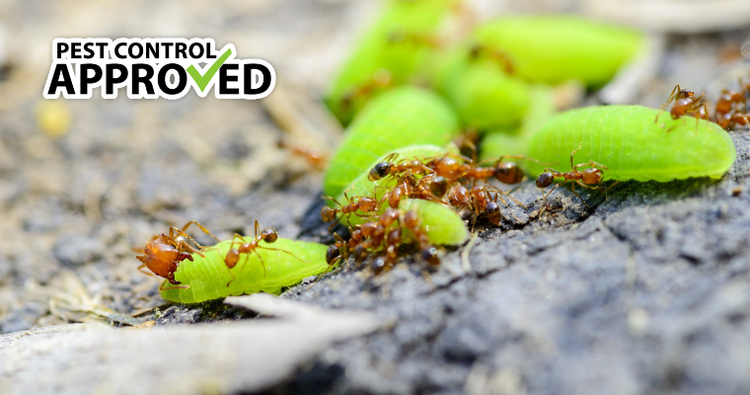
True Fire Ants
True Fire Ants are rarely found in Canada. They are native to South America but migrated to the South-central USA, especially along coastlines. While they are occasionally brought into Alberta via transported goods, they cannot survive our cold, dry climate. True fire ants are in the solenopsis genius and are in the same family as wasps. They are medium red to deep black in color with two segmented clubs at the end of their antennae. They are between two to six millimeters (0.08 inch to ¼ inch). Unlike most ants, they have two nodes between their thorax and abdomen.
Fire ants are dangerous because they are aggressive and attack in large numbers. If you so much as step near their nest, they will swarm out to attack. They attach themselves to their victim with their strong jaws and then sting in a circular motion. Their stinger contains venom called solenopsin. This venom is similar to compounds found in black pepper. It is toxic and can cause localized tissue damage. The sting leaves a painful raised bump that fills with pus. The area around the bite also becomes red and swells. The sting can easily become infected if scratched and can even leave a scar. Since these ants swarm victims, people often have many painful bites that become infected. In some individuals, these bites cause severe, even life-threatening, allergic reactions. Fortunately, true fire ants are extremely rare in Alberta.
European Fire Ants
There are two ant species found in Canada that are frequently mistaken for fire ants: the European Fire ant and the Little Fire ant. The European Fire ant is native to Europe and invasive to Canada. They were first spotted in Nova Scotia and are still more common in Eastern Canada than in Western Canada. While less deadly, they are still an aggressive and dangerous species of ant. Their colonies contain at least 1,000 workers and as many as 10, 000 workers.
Description
The Myrmica Rubra or European Fire ant (hereafter called the E. Fire ant) is a tiny species. They are only four to five mm long (5/32 inches to 13/64 inches). They are reddish-brown, often with a darker head. Their bent antennae have twelve segments with a clubbed end made up of four additional segments. These later segments are thicker. Nearly blind, they use these antennae to scent food and find their nests. Their mandibles (mouth parts) are average sized but unable to chew. They can only sip liquids.
Their thorax, the middle part of an ant’s body, contains their six legs and, on a drone, their wings. Workers have no wings. Two segments or nodes connect their thorax to their abdomen. There are two backwards pointing spines on the end of their thorax. These are only visible under a microscope. European Fire Ants abdomen is shiny and contains a stinger.
Lifecycle and Breeding
New European Fire ant colonies often begin by ‘colony budding’. Colony budding is where a queen leaves the old nest and creates a new, separate nest. Workers will often follow the queen to the new nest. Unlike many ant species, E. Fire ant colonies have many active queens. Although the lifecycle of E. Fire ant is still being studied, some things are known. Their nuptial flights occur between August and September, depending on the location. They hibernate in winter before laying their eggs in the spring. Some queens hibernate alone while others group together with other queens or stay with their old colony. After hibernation, they being to search out food and a new nesting location. The eggs take two years to develop from eggs to larva to ants. Some eggs develop more rapidly than others, taking about a year. A new colony isn’t fully developed for at least two years. While nuptial flights haven’t been observed in the USA or Canada, the E. Fire ant population continues to spread. The spread may be explained by two factors: queens separating from existing colonies and ants spreading through infested soil. It is likely that the nuptial flights occur in Canada but have not been documented.
Habitat
Fire ants prefer a cool, moist environment. In nature, they commonly nest near water, in the roots of vegetation, inside logs, or under rocks. There are often multiple nests in a small area, such as a yard. They do not produce large mounds at the entrances of their nests and are therefore harder to spot. Their nets often go three to four feet into the earth. Unlike many other ant species, fire ants do not often nest indoors.
Diet
Like Carpenter ants, European Fire ants farm aphids for their honeydew. Honeydew is a substance produced by aphids. The ants provide protection for the aphids while using their antennae to collect the honeydew. Because they have no natural enemies, European Fire Ants may poach aphid colonies from other kinds of ants. European Fire Ants are omnivorous. They will eat the carcasses of other insects or even animals. They also enjoy flowers, nectar. In captive ant farms, it has been reported that they enjoy apples and pears. You can see more information around Ant diets under our Complete Guide to Ants.
Are They Dangerous?
European Fire ants are not as dangerous as true fire ants, but still inflict painful stings. While they do not spray formic acid, it is part of the venom in their stinger. The venom also contains proteins that often cause allergic reactions. Victims of E. Fire ants often report soreness lasting for hours around the site. The inflamed area often extends two to ten centimeters around the sting. Like true fire ants, E. Fire ants are aggressive and will swarm their victims. Disturbing a nest by walking nearby can cause them to attack. Multiple stings increase the chances of an allergic reaction.
Signs of Infestation
Unlike other ants, the first sign of a European Fire ant infestation is often being stung. Although their colonies are large, they can still be hard to spot. E. Fire ant mounds are small and easily hidden. They seldom venture into homes and never build nests inside. Keep an eye out for ant bites on children or pets or for small mounds of disturbed earth around your lawn. The best way to treat for ants is using the right Ant Bait.
Ant Prevention Tips:
- Repair rips in screens or mesh
- Fill cracks or gaps in windows and doors
- Keep house free of crumbs
- Brush pets when they come inside
- Store food in sealed containers
Removal Options:
- Spray ant scent trails with vinegar
- Use ant bait traps indoors
- Remove outdoor colonies near windows and doors
- Use aerosolized insecticide near entry points.


